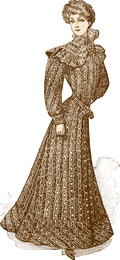Peignoir
This article includes a list of general references, but it lacks sufficient corresponding inline citations. (June 2023) |
A peignoir (/ˈpɛnwɑːr, ˈpeɪnwɑːr/ PEN-war, PAY-nwar, US also /pɛˈnwɑːr, peɪˈnwɑːr/ pen-WAR, pay-NWAR,[1][2][3] French: [pɛɲwaʁ] ) is a long outer garment for women which is frequently sheer and made of chiffon or another translucent fabric. The word comes from French peigner 'to comb [hair]' (from Latin pectināre, from pecten 'comb') describing a garment worn while brushing one's hair, originally referring to a dressing gown, bathrobe or lounging robe.
Very high-end peignoirs were occasionally sold with sheer long gloves and stockings made of the same material as the peignoir itself for wear to bed or on occasions where the wearer would be seen in her nightclothes, such as visiting or while sharing accommodations during travel during the mid-19th to mid 20th centuries.[citation needed] Contemporary peignoirs are usually sold with matching nightgown or panties.
References
[edit]- Kate Chopin's The Awakening (Chapter 3)
- ^ "peignoir". The Chambers Dictionary (9th ed.). Chambers. 2003. ISBN 0-550-10105-5.
- ^ "peignoir". Collins English Dictionary (13th ed.). HarperCollins. 2018. ISBN 978-0-008-28437-4.
- ^ "Definition of peignoir | Dictionary.com". www.dictionary.com. Retrieved 2022-05-01.
External links
[edit] Media related to Peignoirs at Wikimedia Commons
Media related to Peignoirs at Wikimedia Commons



